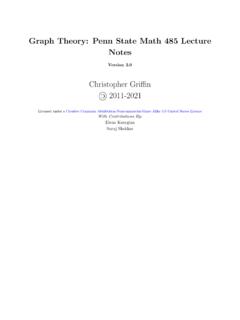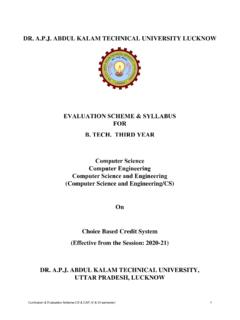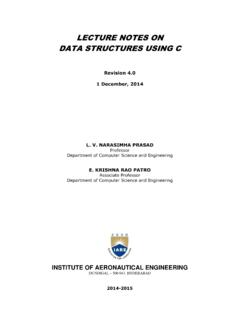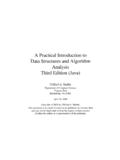Transcription of AbouttheTutorial
1 Data Structures & Algorithms AbouttheTutorial Data Structures are the programmatic way of storing data so that data can be used efficiently. Almost every enterprise application uses various types of data structures in one or the other way. This tutorial will give you a great understanding on Data Structures needed to understand thecomplexity of enterpriselevelapplications andneedofalgorithms, anddata structures. Audience This tutorial is designed for Computer Science graduates as well as Software Professionals who are willing to learn data structures and algorithm programming in simple and easy steps. After completing this tutorial you will be at intermediate level of expertise from where you can take yourself to higher level of expertise. Prerequisites Before proceeding with this tutorial, you should have a basic understanding of C programming language, text editor, and execution of programs, etc.
2 CopyrightandDisclaimer Copyright 2016 by Tutorials Point (I) Pvt. Ltd. All the content and graphics published in this e-book are the property of Tutorials Point (I) Pvt. Ltd. The user of this e-book is prohibited to reuse, retain, copy, distribute or republish any contents or a part of contents of this e-book in any manner without written consent of the publisher. We strive to update the contents of our website and tutorials as timely and as precisely as possible, however, the contents may contain inaccuracies or errors. Tutorials Point (I) Pvt. Ltd. provides no guarantee regarding the accuracy, timeliness or completeness of our website or its contents including this tutorial. If you discover any errors on our website or in this tutorial, please notify us at i Data Structures & Algorithms Compile&ExecuteOnline For most of the examples given in this tutorial you will find Try it option, so just make use of this option to execute your programs on the spot and enjoy your learning.
3 Try the following example using the Try it option available at the top right corner of the following sample code box #include < > int main(){ /* My first program in C */ printf("Hello, World! \n"); return 0; } ii Data Structures & Algorithms TableofContents About the Copyright and Disclaimer ..i Compile & Execute Table of Contents .. iii 1. Overview ..2 Characteristics of a Data Need for Data Structure ..2 Execution Time Basic Terminology ..3 2. Environment Try it Option Local Environment Installation on Installation on Mac Installation on 3. Algorithms Characteristics of an How to Write an Algorithm? ..9 Algorithm Algorithm Space Complexity ..11 Time 4. Asymptotic Asymptotic Common Asymptotic 5. Greedy Counting 6.
4 Divide & Merge/Combine ..19 7. Dynamic iii Data Structures & Algorithms DATA STRUCTURES ..21 8. Basic Data Definition ..22 Data Data Basic 9. Arrays ..24 Array Representation ..24 Basic Insertion Array Insertion at the Beginning of an Array ..28 Insertion at the Given Index of an Array ..30 Insertion After the Given Index of an Array ..32 Insertion Before the Given Index of an Deletion Search Update LINKED 10. Linked List Linked List Representation ..42 Types of Linked List ..42 Basic Insertion Deletion Reverse Linked List Program in C ..46 11. Doubly Linked Doubly Linked List Basic Insertion Deletion Insertion at the End of an Doubly Linked List Program in 12. Circular Linked Singly Linked List as Doubly Linked List as Basic Insertion Deletion Display List Circular Linked List Program in iv Data Structures & Algorithms STACK & 13.
5 Stack Basic peek()..76 isfull()..77 isempty()..77 Push Pop Operation ..79 Stack Program in 14. Expression Parsing ..84 Infix Prefix Notation ..84 Postfix Parsing Expressions ..85 Postfix Evaluation Expression Parsing Using 15. Queue Representation ..92 Basic peek()..93 isfull()..93 isempty()..94 Enqueue Operation ..95 Dequeue Queue Program in C ..98 SEARCHING 16. Linear Search ..103 Linear Search Program in C ..104 17. Binary How Binary Search Works? ..107 Binary Search Program in C ..110 18. Interpolation Search ..113 Positioning in Binary Search ..113 Position Probing in Interpolation Interpolation Search Program in C ..116 19. Hash Table ..118 Linear Basic Data v Data Structures & Algorithms Hash Search Insert Operation ..121 Delete Hash Table Program in C ..123 SORTING 20.
6 Sorting In-place Sorting and Not-in-place Sorting ..129 Stable and Not Stable Adaptive and Non-Adaptive Sorting Important 21. Bubble Sort Algorithm ..132 How Bubble Sort Works?..132 Bubble Sort Program in C ..136 22. Insertion How Insertion Sort Works? ..140 Insertion Sort Program in C ..143 23. Selection How Selection Sort Works?..147 Selection Sort Program in 24. Merge Sort Algorithm ..153 How Merge Sort Works? ..153 Merge Sort Program in 25. Shell Sort ..158 How Shell Sort Works?..158 Shell Sort Program in 26. Quick Partition in Quick Sort ..166 Quick Sort Pivot Quick Sort Pivot Pseudocode ..167 Quick Sort Quick Sort Quick Sort Program in C ..168 GRAPH DATA 27. Graphs ..173 Graph Data Structure ..173 Basic vi Data Structures & Algorithms 28. Depth First Depth First Traversal in C.
7 179 29. Breadth First Breadth First Traversal in C ..186 TREE DATA STRUCTURE ..192 30. Tree ..193 Important Binary Search Tree Tree BST Basic Insert Operation ..195 Search Tree Traversal in 31. Tree In-order Pre-order Post-order Tree Traversal in 32. Binary Search Basic Search Insert Operation ..215 33. AVL AVL Rotations ..218 34. Spanning General Properties of Spanning Tree ..222 Mathematical Properties of Spanning Application of Spanning Tree ..223 Minimum Spanning Tree (MST)..223 Minimum Spanning-Tree Kruskal's Spanning Tree Prim's Spanning Tree 35. Max Heap Construction Max Heap Deletion vii Data Structures & Algorithms 36. Recursion Analysis of Time Space Complexity ..237 37. Tower of Hanoi ..238 Tower of Hanoi in 38. Fibonacci Series.
8 249 Fibonacci Iterative Algorithm ..250 Fibonacci Interactive Program in Fibonacci Recursive Algorithm ..252 Fibonacci Recursive Program in viii Data Structures & Algorithms Basics 1 1. Overview Data Structure is a systematic way to organize data in order to use it efficiently. Following terms are the foundation terms of a data structure. Interface Each data structure has an interface. Interface represents the set of operations that a data structure supports. An interface only provides the list of supportedoperations,typeof parameters they can acceptandreturntypeof these operations. Implementation Implementation provides the internal representation of a data structure. Implementation also provides the definition of the algorithms used in the operations of the data structure.
9 CharacteristicsofaDataStructure Correctness Data structure implementation should implement its interface correctly. Time Complexity Running time or the execution time of operations of data structure must be as small as possible. Space Complexity Memory usage of a data structure operation should be as little as possible. NeedforDataStructure As applications are getting complex and data rich, there are three common problems that applications face now-a-days. Data Search Consider an inventory of 1 million(106) items of a store. If the application is to search an item, it has to search an item in 1 million(106) items every time slowing down the search. As data grows, search will become slower. Processor Speed Processor speed although being very high, falls limited if the data grows to billion records. Multiple Requests As thousands of users can search data simultaneously on a web server, even the fast server fails while searching the data.
10 To solve the above-mentioned problems, data structures come to rescue. Data can be organized in a data structure in such a way that all items may not be required to be searched, and the required data can be searched almost instantly. 2 Data Structures & Algorithms ExecutionTimeCases Therearethreecases which areusually usedtocomparevarious data structure's execution time in a relative manner. Worst Case This is the scenario where a particular data structure operation takes maximum time it can take. If an operation's worst case time is (n) then this operation will not take more than (n) time, where (n) represents function of n. Average Case This is the scenario depicting the average execution time of an operation of a data structure. If an operation takes (n) time in execution, then m operations will take m (n) time.













